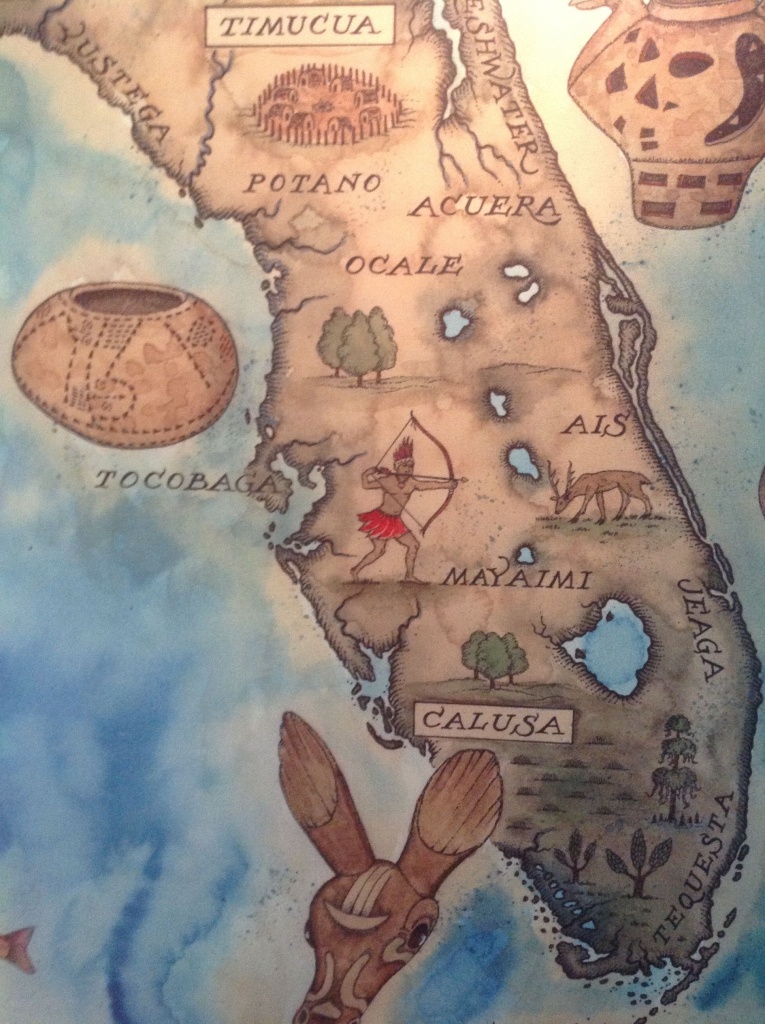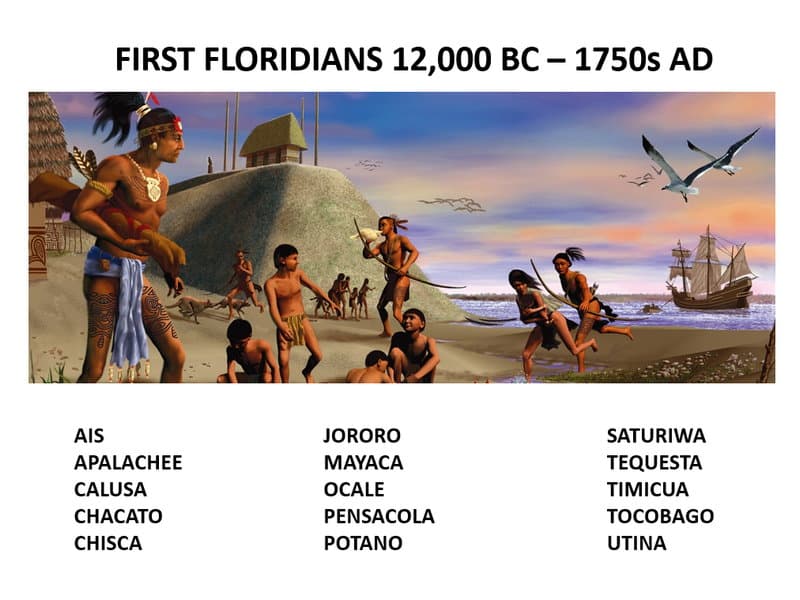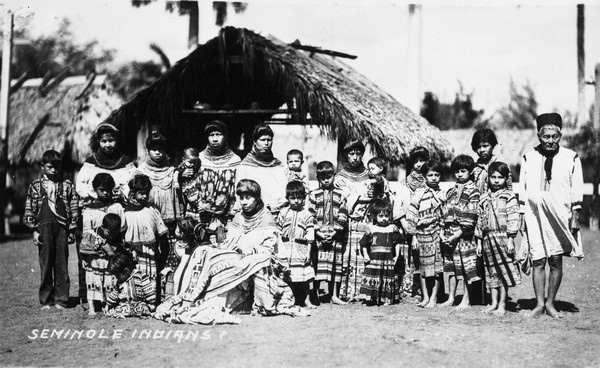A Journey Through Time: Exploring the Rich History of Florida’s Native American Tribes
A Journey Through Time: Exploring the Rich History of Florida’s Native American Tribes

Florida, the Sunshine State, is known for its vibrant beaches, diverse ecosystems, and bustling cities. But beneath the surface of this modern landscape lies a rich and fascinating history, woven deeply into the fabric of the land by its indigenous inhabitants. For centuries, numerous Native American tribes called Florida home, leaving behind a legacy of culture, tradition, and resilience that continues to resonate today.
This article delves into the history of Florida’s Native American tribes, exploring their unique identities, cultural practices, and the challenges they faced throughout time. We’ll uncover the stories of these resilient people, their connection to the land, and their enduring spirit.
Related Articles: A Journey Through Time: Exploring the Rich History of Florida’s Native American Tribes
- Unveiling the Tapestry of Native American Life on Reservations Today
- Discover The Enigmatic Lakota Man: Unveiling the Untold Story!
- Crow Mythology Unveiled: Legends, Spirits & Ancient Lore
- Awaken with the Lakota Morning Star: A Journey Through Inspiration and Beauty
- DiscoverEmbark on an Artistic Odyssey: Uncover the Top Destination for Aboriginal Masterpiece
The First Inhabitants: Paleo-Indians and Archaic Peoples
The story of Florida’s Native American tribes begins thousands of years ago. Archaeological evidence suggests that the first humans arrived in Florida during the Paleo-Indian period, approximately 12,000 years ago. These early inhabitants were nomadic hunter-gatherers, adapting to the changing environments of the Pleistocene era.
The Archaic period, spanning from 8,000 to 2,500 years ago, saw the emergence of more settled communities. These groups developed a deeper understanding of the land, utilizing its resources for sustenance and creating tools and weapons from stone, bone, and wood.
The Rise of Distinct Tribal Groups
As time progressed, distinct tribal groups emerged, each with their own unique language, culture, and territory. These groups, who inhabited various regions of Florida, included:
1. The Calusa:
- Location: Southwestern Florida, primarily along the Caloosahatchee River and the Gulf Coast.
- Culture: Known for their impressive mound-building skills, sophisticated social structure, and mastery of canoe construction. Their economy was based on fishing, hunting, and agriculture.
- Legacy: The Calusa were fierce warriors and skilled navigators, controlling trade routes and establishing a powerful empire that lasted for centuries. Their influence extended across the southern part of the peninsula.

2. The Seminole:
- Location: Central and southern Florida, primarily in the Everglades and the surrounding areas.
- Culture: The Seminole were a diverse group of people, formed by the amalgamation of various Creek tribes who migrated from the Southeast. They were known for their adaptability, resilience, and strong resistance against European colonization.
- Legacy: The Seminole are known for their enduring spirit and their resistance to forced removal, culminating in the Second Seminole War (1835-1842) and the establishment of the Seminole Nation of Oklahoma.

3. The Timucua:

- Location: Northeastern Florida, along the St. Johns River and the Atlantic Coast.
- Culture: The Timucua were a large and complex group, with numerous villages and a sophisticated social structure. They were skilled farmers, fishermen, and artisans, known for their intricate pottery and beadwork.
- Legacy: The Timucua faced significant challenges due to European colonization and disease. While their language is extinct, their legacy lives on in the archaeological sites and cultural artifacts found throughout their former territory.
4. The Apalachee:
- Location: North-central Florida, along the Aucilla River and the Gulf Coast.
- Culture: The Apalachee were known for their strong political organization and their role as intermediaries between European powers and other Native American tribes. They were skilled farmers, hunters, and warriors.
- Legacy: The Apalachee were heavily impacted by European diseases and warfare, leading to their decline. However, their legacy can be seen in the archaeological sites and historical records that document their presence in Florida.
5. The Tocobaga:
- Location: West-central Florida, along the Tampa Bay area.
- Culture: The Tocobaga were known for their sophisticated fishing techniques and their trade with European settlers. They were skilled boat builders and navigators, adapting to the unique environment of the Tampa Bay region.
- Legacy: The Tocobaga were heavily impacted by European diseases and warfare, leading to their decline. Their legacy is preserved in archaeological sites and historical accounts.
European Contact and the Impact on Native American Tribes
The arrival of Europeans in Florida in the 16th century marked a turning point in the history of its Native American tribes. While initial encounters were often characterized by trade and diplomacy, European colonization soon brought about significant changes, including:
- Disease: European diseases, such as smallpox, measles, and influenza, decimated Native American populations.
- Forced Removal: European settlers encroached upon Native American lands, leading to conflicts and forced removals.
- Cultural Assimilation: European colonization resulted in the suppression of Native American languages, traditions, and cultural practices.
Resilience and Adaptation
Despite these challenges, Florida’s Native American tribes displayed remarkable resilience and adaptability. Many groups resisted European encroachment through armed conflict, while others sought to adapt to the changing environment by adopting new technologies and forging alliances with other tribes.
The Seminole Legacy
The Seminole, known for their fierce resistance to removal, played a pivotal role in shaping Florida’s history. Their battles with the United States government, particularly the Second Seminole War (1835-1842), became legendary.
After enduring years of conflict, the Seminole were eventually forced to relocate to Oklahoma, although some remained in Florida, establishing communities in the Everglades and other areas. Today, the Seminole Tribe of Florida is a thriving sovereign nation, with a strong cultural identity and a commitment to preserving their traditions.
The Timucua: A Lost Language, but a Lasting Legacy
The Timucua, once a dominant force in northeastern Florida, faced significant challenges due to disease and European colonization. Their language, a unique and complex language family, is now extinct. However, their legacy lives on through archaeological sites, historical records, and the ongoing efforts of linguists and anthropologists to preserve and revitalize their cultural heritage.
The Present and the Future
Today, Florida’s Native American tribes continue to strive for recognition, self-determination, and the preservation of their cultural heritage. They face ongoing challenges, including poverty, lack of access to healthcare and education, and the impact of environmental degradation on their traditional lands.
However, they also demonstrate remarkable strength and resilience. They continue to practice their traditions, maintain their languages, and advocate for their rights. They are actively involved in environmental protection, cultural preservation, and economic development, working to ensure that their legacy endures for generations to come.
Conclusion
The history of Florida’s Native American tribes is a testament to their resilience, adaptability, and enduring spirit. Their stories, woven into the very fabric of the land, remind us of the importance of understanding and respecting the rich cultural heritage that shaped this state. As we explore the vibrant landscapes of Florida, let us remember the legacy of its indigenous inhabitants and strive to honor their contributions to the history and culture of this unique and beautiful place.
FAQs: A Guide to Florida’s Native American Tribes
Q: What are the major Native American tribes in Florida?
A: The major Native American tribes in Florida include the Calusa, Seminole, Timucua, Apalachee, and Tocobaga. Each tribe had its unique culture, language, and territory.
Q: How did European colonization impact Native American tribes in Florida?
A: European colonization brought about significant changes, including the spread of diseases, forced removal from their lands, and cultural assimilation.
Q: Are there any Native American tribes still living in Florida?
A: Yes, the Seminole Tribe of Florida is a sovereign nation with a thriving community in the state.
Q: What are some of the challenges faced by Native American tribes in Florida today?
A: Today, Florida’s Native American tribes face challenges including poverty, lack of access to healthcare and education, and the impact of environmental degradation on their traditional lands.
Q: How can I learn more about Florida’s Native American history and culture?
A: You can visit museums, historical sites, and cultural centers dedicated to Native American history. You can also read books, articles, and online resources about Florida’s indigenous people.
Q: How can I support Native American tribes in Florida?
A: You can support Native American tribes by learning about their history and culture, visiting their cultural centers, and supporting their economic initiatives. You can also advocate for policies that promote their rights and well-being.

Closure
Thus, we hope this article has provided valuable insights into A Journey Through Time: Exploring the Rich History of Florida’s Native American Tribes. We thank you for taking the time to read this article. See you in our next article!


